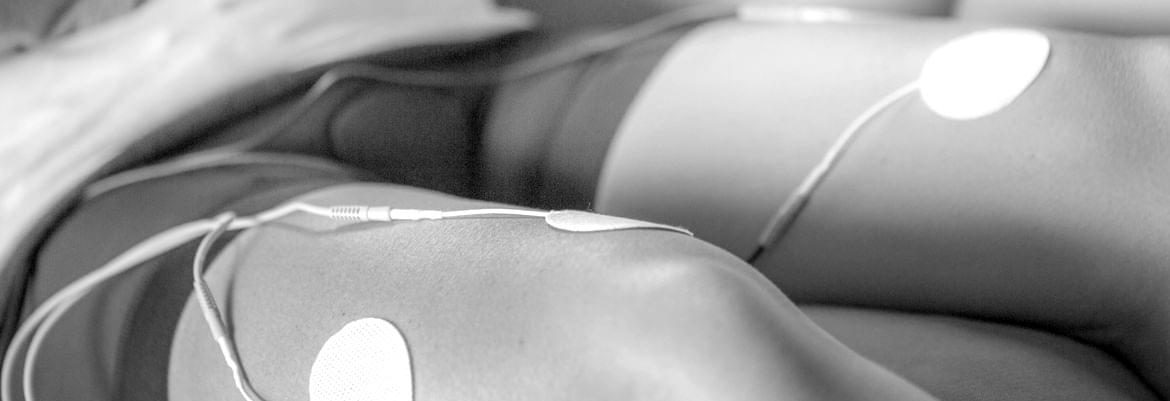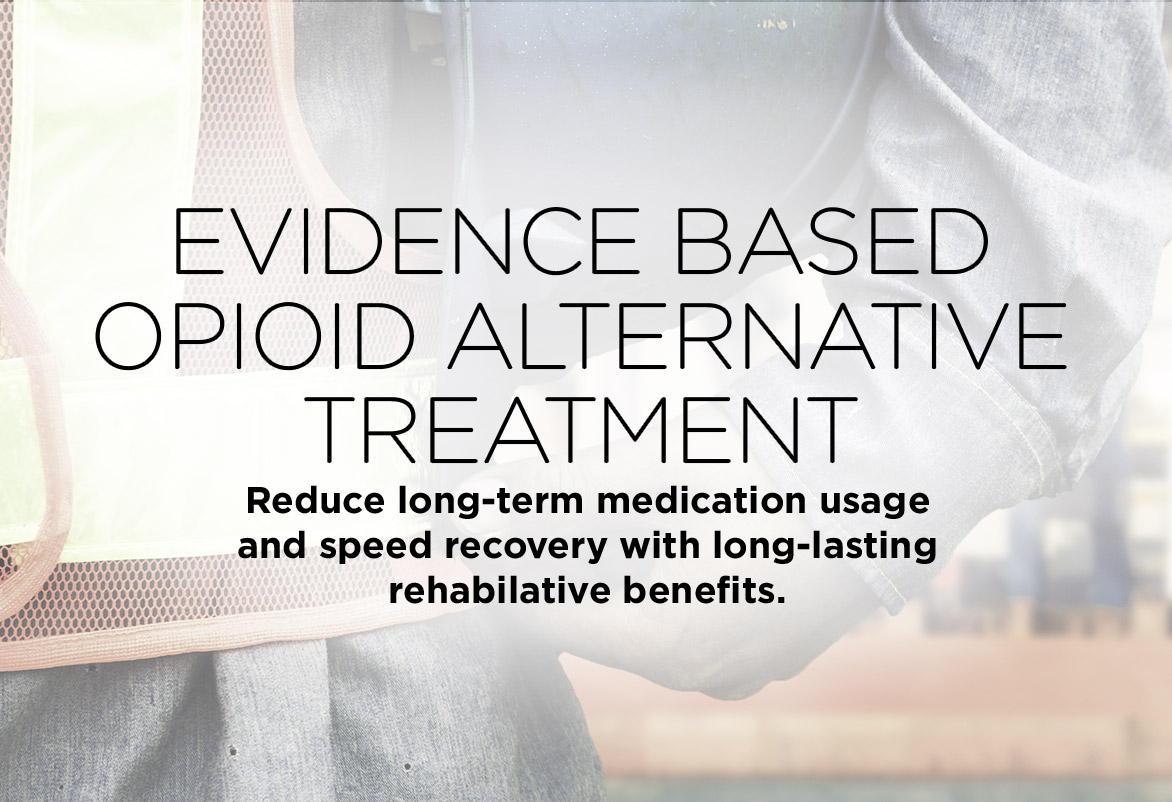For Pain Patients, The Treatment Is Often As Debilitating As The Injury
Acute, chronic, traumatic or post-operative pain is a fact of life for many Americans and their employers: In a single year, pain will affect 100 million Americans,1 cost up to $300 billion,1 and result in 50 million days of lost work. And among those who suffer pain, 58% is chronic3 —lasting at least six months. It’s one of the leading reasons people seek health care, which means it’s one of the leading drivers of health care costs.
There is no shortage of methods to treat pain sufferers, but many of these carry a substantial price tag and health risks.
- NSAIDS are not safe or effective for long-term use and may produce side effects such as ulcers and heart problems4
- Muscle relaxants produce a substantial demotivating effect that may actually hinder a return to function5
- Steroid injections carry a higher price tag and may weaken tissues7
- Narcotics/opioids are physically and psychologically addicting,8 and prescriptions have increased fourfold over the past decade9
- Often, multiple prescriptions are required to treat a single condition, costing hundreds or even thousands of dollars a month and increasing health risks
With opiate abuse and addiction on the rise, there’s never been a greater need for effective, non-pharmacologic pain relief.
Instead of promoting relief and recovery, narcotic pain relievers often result in:
- More absences: Workers who received high doses of opioid painkillers stayed out of work three times longer than those with similar injuries who took lower doses10
- Inflated costs: The cost of a workplace injury is nine times higher when a strong narcotic such as OxyContin is involved10
- Lingering claims: Applicants with only one opioid prescription had a claims closure rate of 87%, but the claims closure rate steadily decreased when the number of opioid prescriptions increased11
H-Wave® provides a drug-free opioid alternative treatment for post‑op care too. Click here to learn more.

Even drug-free treatment options have substantial limitations—and no guarantee the patient can return to normal function.
Physical therapy: Often can’t address day to day symptoms, costs an average of $1,200 per month ($100 per visit, three visits per week)
Surgery: Substantial risks and costs that can climb into six figures, continued drug use
Electronic stimulation, such as TENS: Only masks pain while the device is connected to the patient

H-Wave® Provides Benefits That Traditional Therapies and Medications Can’t
WHAT SETS H-WAVE APART
By providing a drug-free treatment option that delivers pain relief and facilitates recovery, Home H-Wave is a viable alternative to the traditional prescription medications that often fail to return patients to health and end up costing payors hundreds of millions of dollars a year.
THE H-WAVE DIFFERENCE
- Will not cause demotivating factors such as depression or drop in energy levels
- Unlike TENS, H-Wave continues to deliver benefits even after treatment
- Home H-Wave is available to the patient 24 hours a day, seven days a week
How It Works
With two different treatment modes, H-Wave can be used during multiple phases of injury and recovery
MODE 1: LOW FREQUENCY
Active Rehabilitation to Unblock the Pathway to Recovery
This low-frequency mode contracts muscle fibers to promote blood flow, lymphatic circulation, and tissue rehabilitation for accelerated recovery.
Mode 2: HIGH FREQUENCY
Breaking the Chronic Pain Cycle
This high-frequency mode is designed to manage chronic, post-surgical, and post-traumatic pain by shutting down your pain signals within the nerve, providing lasting pain relief that is so effective that the FDA has cleared the H-Wave for use as dental anesthesia.
"Although I cannot speak for the insurance industry, it is my opinion and from personal experience that avoidance of potential drug/opiate dependency and possible addiction is a necessary mandate in the treatment of pain. Using any acceptable non-drug therapy such as H-Wave should be viewed as a necessary technique in the arsenal of treatment."
- Lester Sacks MD, PhD, Board Certified Specialist in Occupational Medicine, Consulting Medical Director for several insurance companies

Field-tested and clinically proven, year-after-year.
While drugs and other treatments only mask the pain, H-Wave has been shown to provide benefits that speed recovery, reduce the need for medication, and return users to work faster.
- 79% of H-Wave users reported functional improvements that made it possible to return to activities such as walking, lifting, and‑sleeping12
- 78% of H-Wave users reported significant pain relief12
- 65% of users were able to reduce or completely eliminate the need for pain medicine12
Home H-Wave provides direct benefits to providers:
- Reduced medication usage
- Increased functional capacity
- Drug-free pain relief
- A smarter spend: H-Wave offers special fixed cost/one-time cost programs to take away the ongoing costs of DME
- No compensation or financial incentive to physician for prescribing home H-Wave
- We monitor patient compliance and outcomes and can provide comprehensive reports for payors
- A more cost-effective treatment tool for post-surgical patients

H-Wave® Is Convenient For Patients To Use
- Home H-Wave creates no work restrictions
- In-home use means patients are more likely to remain compliant with their treatment regimen
- Patients receive thorough training and education
- 30-Day Money Back Guarantee: If a patient isn’t satisfied after 30 days of use, he or she may return it for a full refund, with no cost to the physician, clinic, or insurance company
“My back, neck, upper back, and middle back hurts me so much. I’ve had steroids, cortisone shots, PT; they never helped me like the H-Wave.”
- Home Patient, Back Condition, Winter Haven, FL
“My H-Wave helped me go back to work. This unit is amazing. It also got me off my pain medications that I was taking for 4 years."
- Home Patient, Back Condition, Citrus Heights, CA

H-Wave® Gives You A New Option For Treating Soft Tissue Injuries And Chronic Pain
This scientifically proven, drug-free alternative not only relieves pain but also helps patients achieve long-lasting, rehabilitative benefits.
Benefits of Home H-Wave:
- Safe, non-addictive pain relief
- Speeds recovery
- Helps restore function
- Makes physical therapy more productive
- Returns patients to work faster
H-Wave is FDA cleared for:
- Chronic, acute, traumatic and post-operative pain
- Increasing circulation
- Relieving muscle spasm
- Increasing range of motion
- Preventing muscle atrophy
1. Gaskin DJ, Richard P. The economic costs of pain in the United States. In: Relieving Pain in America: A Blueprint for Transforming Prevention, Care, Education, and Research. Washington, DC: National Academies Press; 2011. http://www.ncbi.nlm.nih.gov/books/NBK92521. Accessed October 27, 2014. 2. Joint Commission on Accreditation of Healthcare Organizations, National Pharmaceutical Council. Pain: current understanding of assessment, management and treatments. December 2001. http://www.npcnow.org/system/files/research/download/Pain-Current-Understanding-of-Assessment-Management-and-Treatments. pdf. Accessed October 27, 2014. 3. Study estimates persistent pain incidence at 19% of U.S. adults [press release]. Chicago, IL: American Pain Society; October 27, 2014. http: //americanpainsociety.org/about-us /press-room/persistent-pain-incidence-news-release. Accessed October 28, 2014. 4. NSAIDs: Nonsteroidal anti-inflammatory drugs. American College of Rheumatology website. http://www.rheumatology.org /Practice/Clinical/Patients/Medications/NSAIDs_Nonsteroidal_Anti-inflammatory_Drugs. Updated August 2012. Accessed October 27, 2014. 5. Glass LS, Blais BB, Genovese E, Goertz M, Harris JS, Hoffman H, et al (eds). Occupational Medicine Practice Guidelines: Evaluation and Management of Common Health Problems and Functional Recovery in Workers. 2nd ed. Beverly Farms, MA: OEM Health OEM Health Information Press; 2004:115. 6. Okamoto S. 4th DCA weighs in on reasonable value of epidural injections. Workers Compensation News. November 19, 2013. https://ww3.workcompcentral.com/news/story/id /9a4e6a99c70c6b212d3cb35e33098df7s. Accessed October 28, 2014. 7. Mayo Clinic staff. Cortisone shots risks. Mayo Clinic website. http://www.mayoclinic.org/tests-procedures/cortisone-shots/basics/risks/ prc-20014455. Updated August 13, 2013. Accessed October 27, 2014. 8. Pain management: drug tolerance and addiction. WebMD website. http://www.webmd.com/pain-management/guide/drug-toleranceaddiction. Updated April 23, 2013. Accessed October 28, 2014. 9. Centers for Disease Control and Prevention (CDC). Addressing prescription drug abuse in the United States. http://www.cdc.gov /HomeandRecreationalSafety/pdf/HHS_Prescription_Drug_Abuse_Report_09.2013.pdf. Accessed February 17, 2015. 10. CorVel Corporation. Focus on pharmacy management: new insights for pain management. CorVel website. http://www.corvel.com/media/37190/Whitepaper_Pain_Management.pdf. Accessed February 16, 2015. 11. Kamin JP. CWCI: Multiple opioids tied to higher claims costs. California Workers’CompensationInstitute. http://www.wcc.sc.gov/Documents/Narc%20Use%20Adv%20Comm/WorkCompCenntral%20CWCI%20Multiple%20Popiods%20Tied%20to%20Higher%20Claims%20Costs.pdf. October 29, 2013. Accessed February 16, 2015. 12. Johnson D, Jergler D. Opioid epidemic plagues workers’ comp. Insurance Journal website. http://www.insurancejournal.com/news/national/2013/05/17/292528.htm. Published May 17, 2013. Accessed October 15, 2014.

